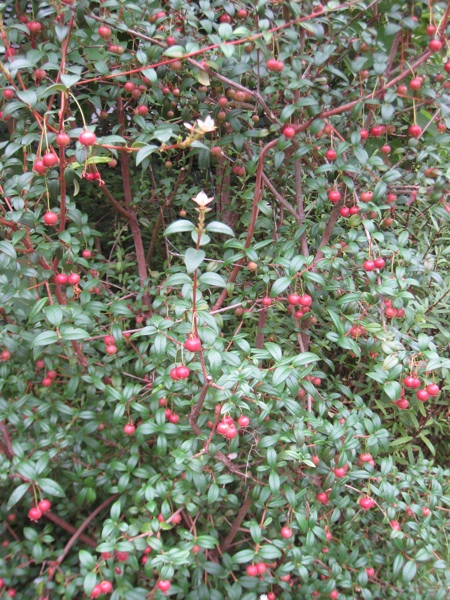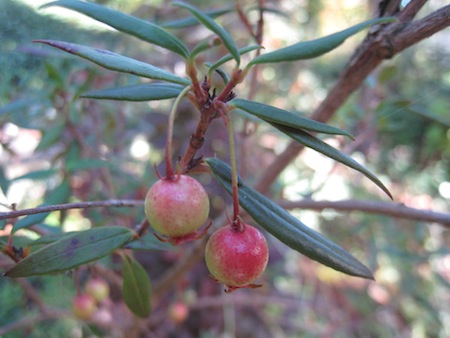
large Chilean guava laden with fruit in November; photo by ALJ
|

Chilean guava flowers; photo by ALJ
|

Chilean guava berries; photo by ALJ
|

slender-leaf Chilean guava flowers; photo by ALJ
|

slender-leaf Chilean guava berries; photo by ALJ
|
| Chilean Guava |
| Chilean Guava; Myrtus Ugni Mol. |
| = Ugni Molinæ Turcz. |
MYRTACEÆ
|
| Guavas in general find our climate too cold. If surviving the hard winters here at all, they do so under protest, shivering and sulking fruitlessly in a frigid torpor. So, we are greatly relieved that the Chilean Guava resists winter injury, remaining largely unruffled. Despite lacking the glamour, the large luscious fruit, attractive bark and hefty size of the other guavas, it still is a choice plant for us. |
Enrich your landscape and spice your diet with a Chilean Guava -- you'll love the result! Since guavas are tropical and sub-tropical, but we are Northwesterners, there fruits are unfamiliar to most of us. Here is a simplified chart of the major kinds known to most North American cultivators; many more guavas exist.
|
| Common or Lemon Guava |
| Psidium Guajava |
Tropical America
|
| Strawberry Guava |
| Psidium littorale = P. Cattleianum |
Brazil
|
| Pineapple Guava |
| Feijoa Sellowiana |
S Brazil, Uruguay, Paraguay, Argentina
|
| Chilean Guava |
| Myrtus Ugni |
Chile
|
| All are related to one another. The Chilean Guava, as noted, is in some cases called Myrtus Ugni (after the vernacular name "Uñi") and otherwise is known as Ugni Molinæ, after Juan Ignacio Molina (1737-1829). The Chilean people call it variously Uñi, Murtillo, Murtilla or Murta. It has been known to Western botanists and gardeners since 1844 -- almost 150 years. |
| As normally grown in California, it is a shrub 2 to 4 feet or rarely 6 feet tall, of wayward, ungainly habit; it is no neat, compact blob. The leaves are small, averaging about half an inch long, shiny dark evergreen, usually a bit puckery-looking and curved, and are plump-textured, with an aroma of beeswax when crushed. The young growth is rich colored and contrasts pleasingly with the mature leaves. |
| During May or June, little creamy, fragrant flowers dangle on slender 1-inch stalks, and, if they are fertilized, develop into pea-sized berries that ripen to dark red or purplish in late summer or fall. Describing the berry flavor is as awkward as trying to tell someone who has never eaten an orange what one tastes like! Nonetheless, the flavor is estimable, the texture no problem and the seeds tiny. |
| The bush is easily raised from seeds and cuttings. It can perform well in most soils and in either full sun or shade. It flowers and fruits even while very small. I've had four specimens since 1987, and have eaten fruit from all but one. All four made it alive (though not undamaged) through the viciously freezing winters without protection. |
| Evidently there are two very dissimilar races. One is common, the other rare. Luckily the common sort is superior in looks, hardiness and fruit quality! The rare kind has longer, narrower leaves and darker, smaller, less delectable berries (and is probably what has been called Myrtus Ugni var. Poeppigii Kuntze or Ugni Poeppigii Berg.). The common Chilean Guava can be found at California nurseries and is occasionally offered in our area --but is still too rare. |
If you go to a local nursery and ask, "Do you have any Chilean Guavas for sale?" you will likely be told, "No, because they do not grow here. See the Sunset book says so." Tell the nursery manager to order a shipment from California, that the business about it not growing here is utterly untrue! Use the shrubs in place of common boxwood, dwarf Japanese hollies, Kurume azaleas, etc. Rich compost will benefit them, and if an unusually cold winter comes you can expect some twig ends to die. Probably a cover will prevent such damage. Certainly trying the Chilean Guava as a potted plant is also worthwhile. In any case, get one and enjoy it.
|
(Originally published in the May 1990 Seattle Tilth newsletter, along with an illustration borrowed from Flores Silvestres de Chile. Since the article was written I have some interesting news: in 2001 I noticed two wild seedlings pop up in my garden. There might have been more in earlier years if I had not eaten all of the berries.
Also, the trademarked name Tassi berry is now applied to these fruits, at least in Australia.)
Back |

